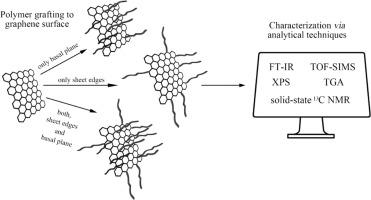当前位置:
X-MOL 学术
›
Eur. Polym. J.
›
论文详情
Our official English website, www.x-mol.net, welcomes your
feedback! (Note: you will need to create a separate account there.)
Photo-induced copper-mediated (meth)acrylate polymerization towards graphene oxide and reduced graphene oxide modification
European Polymer Journal ( IF 5.8 ) Pub Date : 2020-07-01 , DOI: 10.1016/j.eurpolymj.2020.109810 Svitlana Railian , Joris J. Haven , Lowie Maes , Dries De Sloovere , Vanessa Trouillet , Alexander Welle , Peter Adriaensens , Marlies K. Van Bael , An Hardy , Wim Deferme , Tanja Junkers
European Polymer Journal ( IF 5.8 ) Pub Date : 2020-07-01 , DOI: 10.1016/j.eurpolymj.2020.109810 Svitlana Railian , Joris J. Haven , Lowie Maes , Dries De Sloovere , Vanessa Trouillet , Alexander Welle , Peter Adriaensens , Marlies K. Van Bael , An Hardy , Wim Deferme , Tanja Junkers

|
Abstract The preparation of well-dispersed graphene/polymer nanocomposites is challenging due to the poor miscibility of graphene sheets in a polymer matrix. To enhance the interaction between both phases, graphene sheets can be decorated with polymer chains. Herein, different strategies to graft poly(methyl methacrylate) (PMMA) and poly(di(ethylene glycol) ethyl ether acrylate) (PDEGA) chains at various positions on graphene oxide and reduced graphene oxide (GO/rGO) sheets are compared. Chain attachment was achieved by “grafting-to” and “grafting-from” methods. Grafting-to was performed by classical copper (I)-catalyzed alkyne azide cycloaddition. Using a grafting-from approach, PMMA and PDEGA brushes were grown from GO and rGO sheets via surface-initiated photo-induced copper-mediated polymerization (SI-photoCMP). SI-photoCMP is a robust and efficient method that allows polymerizations to be carried out under mild conditions and with reduced catalyst concentration. Moreover, the successful implementation of SI-photoCMP in a continuous-flow set-up enables easy upscaling of the system and is, therefore, a more efficient and environmentally friendly process for GO/rGO surface modification. By using the grafting-to approach, the grafting density of PMMA (Mn = 2,600 g/mol) was one chain per 990 carbons of graphene. In contrast, longer PMMA chains (Mn = 40,300 g/mol) and higher grafting density were obtained via the grafting-from method (one PMMA chain per 140 carbons of graphene).
中文翻译:

光诱导铜介导的(甲基)丙烯酸酯聚合向氧化石墨烯和还原氧化石墨烯改性
摘要 由于石墨烯片在聚合物基质中的相容性差,制备分散良好的石墨烯/聚合物纳米复合材料具有挑战性。为了增强两相之间的相互作用,石墨烯片可以用聚合物链装饰。在此,比较了在氧化石墨烯和还原氧化石墨烯 (GO/rGO) 片材上的不同位置接枝聚(甲基丙烯酸甲酯)(PMMA)和聚(二(乙二醇)乙基醚丙烯酸酯)(PDEGA)链的不同策略。链附着是通过“嫁接”和“嫁接”方法实现的。通过经典的铜 (I) 催化的炔烃叠氮化物环加成进行接枝。使用嫁接方法,PMMA 和 PDEGA 刷子通过表面引发的光诱导铜介导聚合 (SI-photoCMP) 从 GO 和 rGO 片生长。SI-photoCMP 是一种稳健有效的方法,可以在温和的条件下和降低催化剂浓度的情况下进行聚合。此外,在连续流动装置中成功实施 SI-photoCMP 可以轻松升级系统,因此是一种更有效和更环保的 GO/rGO 表面改性工艺。通过使用接枝方法,PMMA 的接枝密度(Mn = 2,600 g/mol)为每 990 个石墨烯碳一个链。相比之下,通过接枝法(每 140 个石墨烯碳有一个 PMMA 链)获得了更长的 PMMA 链(Mn = 40,300 g/mol)和更高的接枝密度。在连续流动装置中成功实施 SI-photoCMP 可以轻松升级系统,因此是一种更高效、更环保的 GO/rGO 表面改性工艺。通过使用接枝方法,PMMA 的接枝密度(Mn = 2,600 g/mol)为每 990 个石墨烯碳一个链。相比之下,通过接枝法(每 140 个石墨烯碳有一个 PMMA 链)获得了更长的 PMMA 链(Mn = 40,300 g/mol)和更高的接枝密度。在连续流动装置中成功实施 SI-photoCMP 可以轻松升级系统,因此是一种更高效、更环保的 GO/rGO 表面改性工艺。通过使用接枝方法,PMMA 的接枝密度(Mn = 2,600 g/mol)为每 990 个石墨烯碳一个链。相比之下,通过接枝法(每 140 个石墨烯碳有一个 PMMA 链)获得了更长的 PMMA 链(Mn = 40,300 g/mol)和更高的接枝密度。
更新日期:2020-07-01
中文翻译:

光诱导铜介导的(甲基)丙烯酸酯聚合向氧化石墨烯和还原氧化石墨烯改性
摘要 由于石墨烯片在聚合物基质中的相容性差,制备分散良好的石墨烯/聚合物纳米复合材料具有挑战性。为了增强两相之间的相互作用,石墨烯片可以用聚合物链装饰。在此,比较了在氧化石墨烯和还原氧化石墨烯 (GO/rGO) 片材上的不同位置接枝聚(甲基丙烯酸甲酯)(PMMA)和聚(二(乙二醇)乙基醚丙烯酸酯)(PDEGA)链的不同策略。链附着是通过“嫁接”和“嫁接”方法实现的。通过经典的铜 (I) 催化的炔烃叠氮化物环加成进行接枝。使用嫁接方法,PMMA 和 PDEGA 刷子通过表面引发的光诱导铜介导聚合 (SI-photoCMP) 从 GO 和 rGO 片生长。SI-photoCMP 是一种稳健有效的方法,可以在温和的条件下和降低催化剂浓度的情况下进行聚合。此外,在连续流动装置中成功实施 SI-photoCMP 可以轻松升级系统,因此是一种更有效和更环保的 GO/rGO 表面改性工艺。通过使用接枝方法,PMMA 的接枝密度(Mn = 2,600 g/mol)为每 990 个石墨烯碳一个链。相比之下,通过接枝法(每 140 个石墨烯碳有一个 PMMA 链)获得了更长的 PMMA 链(Mn = 40,300 g/mol)和更高的接枝密度。在连续流动装置中成功实施 SI-photoCMP 可以轻松升级系统,因此是一种更高效、更环保的 GO/rGO 表面改性工艺。通过使用接枝方法,PMMA 的接枝密度(Mn = 2,600 g/mol)为每 990 个石墨烯碳一个链。相比之下,通过接枝法(每 140 个石墨烯碳有一个 PMMA 链)获得了更长的 PMMA 链(Mn = 40,300 g/mol)和更高的接枝密度。在连续流动装置中成功实施 SI-photoCMP 可以轻松升级系统,因此是一种更高效、更环保的 GO/rGO 表面改性工艺。通过使用接枝方法,PMMA 的接枝密度(Mn = 2,600 g/mol)为每 990 个石墨烯碳一个链。相比之下,通过接枝法(每 140 个石墨烯碳有一个 PMMA 链)获得了更长的 PMMA 链(Mn = 40,300 g/mol)和更高的接枝密度。











































 京公网安备 11010802027423号
京公网安备 11010802027423号